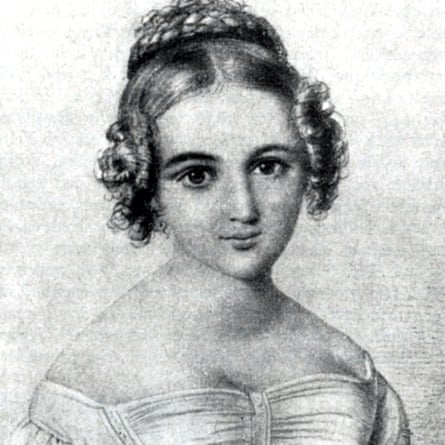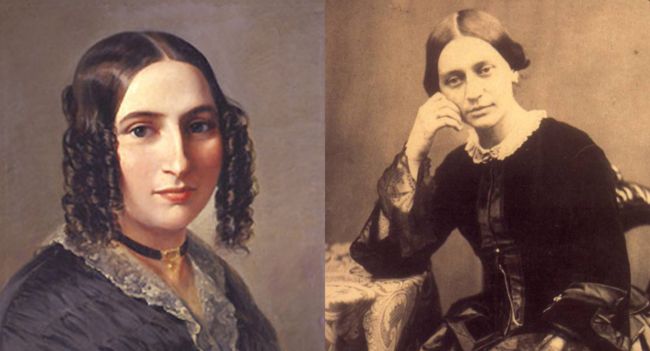To read the family’s account, you’d never know that Fanny Mendelssohn, Felix’s big sister, was also a composer of genius. Her own son, my great-great-grandfather Sebastian, paints a vivid picture of her in his history of the family: funny, brilliant, affectionate. But not a word about her as a musician.
So it was not until I made a film about Felix for the BBC in 2009 that I began to discover Fanny’s extraordinary gifts; and also, her lifelong struggle between a desire for self-expression and the horror of upsetting the family. What made it even more compelling was that, for Fanny, the struggle was largely with herself. And that was the start of my documentary Fanny: The Other Mendelssohn.
Today, 176 years after Fanny’s death, things have moved on a lot. There are women holding powerful positions in many fields that secure them material rewards.

But making art, or music, isn’t like that. It’s more like a child’s play; there may be a question to answer, or just a pattern of shapes and colours to be expressed. And the only way to approach it is to begin and see where it takes you, which may be nowhere, for days or even weeks at a time. It takes a lot of nerve and confidence to insist that this apparently random and pointless activity, of interest to nobody but yourself, really matters. The kind of confidence that comes from the conviction that you’re an artist.
That was what Fanny Mendelssohn Hensel was up against. The model of a creative artist just didn’t look, or feel, like her. Fanny wanted what many people want: a loving marriage, a happy family with children – and not to upset her parents.
And here was her problem. The Mendelssohns, having made a fortune in banking and converted from Judaism to Christianity, were trying to become part of Berlin nobility. Any misstep would be noted and punished. So although Fanny’s musical gift was considered equal to her brother’s, when she was 14 her father Abraham abruptly ended her musical education and wrote this to her: “Music will perhaps become his profession, whilst for you it can and must only be an ornament, never the root of your being and doing”.
Fanny was still allowed to compose and perform, but only in private. And yet inconveniently, she turned out to have a talent so enormous it spilled over into everything she did.
So her life was a relentless battle to balance these forces. Shortly after she had her first baby, a cholera epidemic swept through Europe. In an age before antibiotics or an organised health system, 26-year-old Fanny was the family nurse. She saw them through the crisis and celebrated by writing a Cholera Cantata, 40 minutes of complicated four-part singing, with an organ accompaniment. It was one of three cantatas she wrote that year, in between the nursing, feeding students who turned up to learn from her artist husband Wilhelm, and keeping track of the 240 embroidered napkins a well-ordered household required.
But Felix didn’t like the cantatas, and told her she had no gift for choral composition. She never wrote one again.
This was Fanny’s curse: although her talent was evident to all who met her, without a role model she had no confidence in it. There was only one person whose judgment she trusted, with high enough standards and obvious enough talent: her little brother Felix. When he liked something, she was ridiculously pleased; but when he didn’t, she gave up immediately. And so her life was littered with one-offs: one string quartet, one set of cantatas.
And yet she persevered. One of many things I love about Fanny is that she was neither a furious rebel nor a tragic victim. (Even when she finally dared to defy Felix and publish her work, she earnestly reassured him, “I’m no ‘femme libre’” – no fear of scandal there). The prospect of never having a career didn’t stop her composing. When her parents objected to the man she loved because he was a struggling artist, she waited for him until he got a proper job, as painter to the King. (Wilhelm is the hero of this fairytale: despite a tin ear for music and a total absence of the Mendelssohns’ rapier wit, he refused to marry Fanny unless she continued composing. We have him to thank for all the music that followed.)
One of the biggest challenges of the film was to convey the experience of trying to compose in a world without recorded music. In Fanny’s day, the only way to hear the latest symphony or concerto was to be there, in the concert hall, when it was played. There were “reductions” – arrangements for one or two pianos – of the most popular works, but even two pianos at full volume would be hard-pressed to convey the impact of Beethoven’s Fifth.
Felix travelled throughout Europe, hearing all the latest music and meeting all its greats, but Fanny was stuck at home with a husband and a baby. So she decided if she couldn’t go to where the music was, music should come to her. Luckily, her gilded cage was big enough to accommodate a couple of hundred people, so she became an impresaria, organising an annual season of concerts. Europe’s finest musicians came to lend their talents, but even here, Fanny rarely programmed her own music. The people whose music she showcased were men – particularly her brother.

Her resilience and resourcefulness is echoed in the women who, from the late 1970s onwards, began to find out about Fanny. Marcia Citron travelled from the US to the Staatsbibliothek in Berlin where Fanny’s papers lay uncatalogued and unseen, only to be faced with Dr Rudolf Elvers, guardian of the archive, who explained that Fanny was “nobody, just a housewife”. In the late 1990s, Renate Hellwig-Unruh mounted another assault on the Berlin archive, and when Elvers retired Renate was able to produce the first comprehensive catalogue of what turned out, to everybody’s astonishment, to be over 450 works.
Angela Mace grew up part of a ferociously protective Christian church in the US and was expected, like Fanny, to dedicate her life to raising a family, but she had other ideas. She went to university, won scholarships to pay her fees and discovered, in a postgraduate music seminar, a woman whose story and music, spoke to her across the years. Angela’s encounter with the lost Easter Sonata and her decade-long endeavour to prove Fanny’s authorship gave me the modern-day thread I needed to start the film.
And Isata Kanneh-Mason, another determined woman with few role models but, like Fanny,and a celebrated younger brother, was the perfect musician to learn the Sonata for us, and show, through her encounters with it, everything that makes Fanny’s talent so unarguable.
All of these and many more have said in one way or another that Fanny’s story “feels like me”. However far we’ve come, this lifelong battle is still all too familiar: a battle not just against external resistance and obstacles but, more insidiously, against the inner doubt that we deserve the support, the attention, the space and time afforded to creative artists. The right to play.
